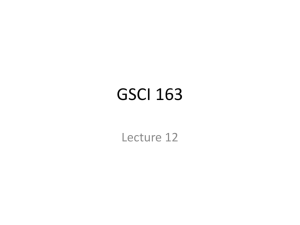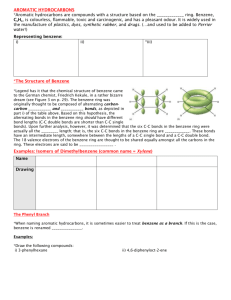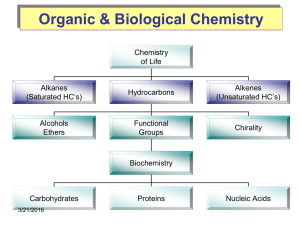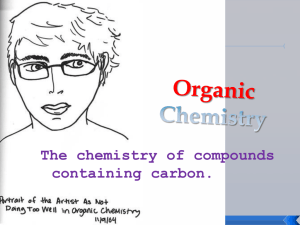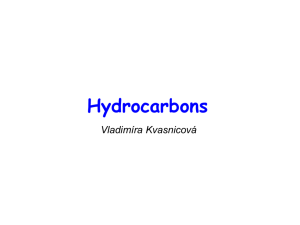Organic Chemistry
advertisement
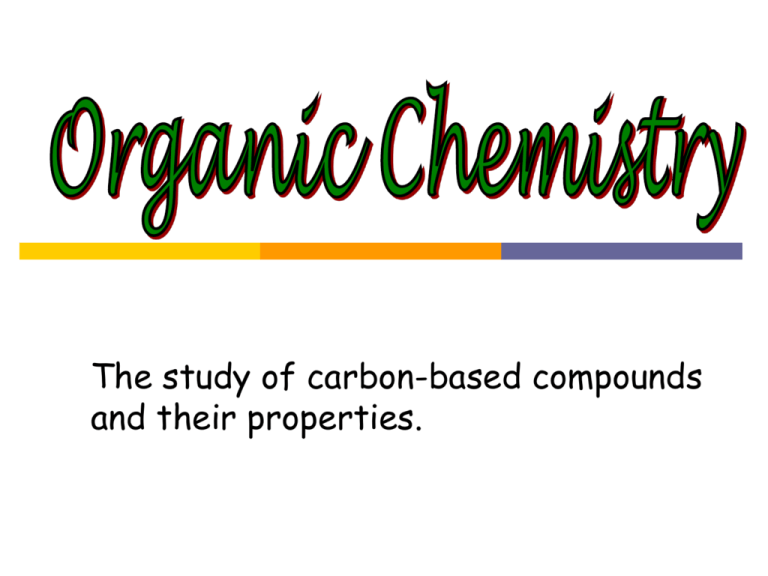
The study of carbon-based compounds and their properties. Historically the distinction between inorganic and organic substances was based on whether or not they were produced by living systems. It was believed that some sort of “life force” was needed to synthesize them. NH4OCN H2N—C—NH2 O urea In 1828, the German chemist Freidrich Wohler (1800-1882) prepared urea from the inorganic salt ammonium cyanate by simple heating. Hydrocarbons: contain only hydrogen and carbon Hydrocarbons can be divided into different types, depending on their bonding. Hydrocarbons Aliphatic Aromatic Alkanes Alkenes Alkynes Cyclic Naming Organic Molecules Alkanes - - Carbon chain, no double or triple bonds. All single bonds (saturated) Alkenes - - Carbon chain, contains double bond(s) (unsaturated) Alkynes - - Carbon chain, contains triple bond(s) (unsaturated) Naming Organic Molecules There are two parts to the main name of each molecule… prefix: tells the # of carbons in main chain or ring suffix: tells the type of bonding in the chain or ring Prefix: indicates number of carbon atoms in the main chain or ring 1 meth- 6 hex- 2 eth- 7 hept- 3 prop- 8 oct- 4 but- 9 non- 5 pent- 10dec- Suffix: indicates types of bonds present Alkanes: (all single bonds) ___ -ane Alkenes: (double bond) ___ -ene Alkyne: (triple bond) ___ -yne Saturated Hydrocarbons: the ALKANES: chains of carbon connected by single bonds: contain only single C-C bonds Saturated v. Unsaturated fats Saturated with H Single bonds are free to rotate, so these fats can pack tightly (solid @ room temp) Which one is saturated? ALKANES ALKANES ALKANES propane, C3H8 ALKANES butane, C4H10 ALKANES pentane, C5H12 ALKANES hexane, C6H14 ALKANES octane, C8H18 Don’t write this example down, but watch to see where we’re going with this… (Although you will be required to include the H’s if you take IB Chemistry) “Normal” v. Branched “normal” hydrocarbons are straight chains; no branching Branched-chain hydrocarbons – isomers of “normal” hydrocarbons; have same formula, but different structures n-butane 2-methlypropane n-pentane 2-methylbutane Are there any other pentane isomers? Another branched alkane: 2,2-dimethylpentane Cycloalkanes cyclopentane Cycloalkanes cyclobutane Cycloalkanes 1 -ethyl- 3 -methylcyclopentane ________________________ methyl3 1 green or red? 22 1 3 ethyl- Unsaturated Hydrocarbons: ALKENES – contain C-C double bonds 2-pentene Unsaturated Hydrocarbons: ALKENES – contain C-C double bonds 2,4-hexadiene Unsaturated Hydrocarbons: ALKYNES – contain C-C triple bonds 1-butyne Unsaturated Hydrocarbons: ALKYNES – contain C-C triple bonds 3-ethyl-1-pentyne Aromatic Hydrocarbons: benzene – the simplest aromatic hydrocarbon; has a symmetrical ring structure Aromatic Hydrocarbons: benzene – can be drawn like this… Derivatives of benzene: 1-ethyl-2-methylbenzene Derivatives of benzene: 1,2-dimethyl-4-propylbenzene For your homework: If a halogen is attached, use the following prefixes: fluorochlorobromoiodo(instead of methyl-, ethyl-, propyl-, etc.)






